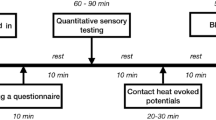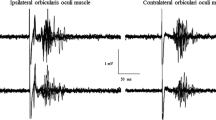Abstract
A diode laser attached with an optic fiber is flexible and adequate for painful cutaneous stimulation. The brain potentials elicited by diode laser stimulation reflect activation of thin-myelinated afferent fibers. This study examined the use of diode laser evoked potentials (LEPs) elicited from the left/right ophthalmic and maxillary branch of the trigeminal nerve. Twelve males (age: 26.3 ± 4.5) participated in this study. A 20W diode laser (980 nm wavelength, 0.5 mm spot diameter) was used for stimulation. The stimulus duration was 250 ms, and inter-stimulus interval was 5 sec. The stimulus intensity was tailored to each individual eliciting mild pinprick pain. Fifty stimuli were delivered to each of the four stimulation sites. A total of 32 channels EEG (-1024 ms to 2048 ms) was recorded. The grand mean averages were evaluated using 3D topographic brain maps. Repeated measure ANOVA was used for statistical comparisons. Ten out of the 12 subjects resulted in a vertex component with major activations described as a negativity (-6.15 to -7.52 mV) peaking around 370 ms and a positivity (14.22 to16.29 mV) peaking around 500 ms. This vertex potential reflected activation of the thin A-delta fiber innervating thermal and nociceptive receptors in the face. This vertex potential to diode laser stimulation may be applicable in clinical studies in patients with neurological affections of the trigeminal nerves or nucleus e.g. before and after surgery. The diode laser may be very useful for clinical neurophysiological purposes due to its applicability and user-friendly function.
Similar content being viewed by others
References
Arendt-Nielsen, L., Gregersen, H., Toft, E. and Bjerring, P. Involvement of thin afferents in carpal tunnel syndrome: evaluated quantitatively by argon laser stimulation. Muscle and Nerve, 1991, 14: 508-514.
Arendt-Nielsen, L. First pain event related potentials to argon laser stimuli: recording and quantification. Journal ofNeurology, Neurosurgery, and Psychiatry, 1990a, 53: 398-404.
Arendt-Nielsen, L. Second pain event related potentials to argon laser stimuli: recording and quantification. Journal of Neurology, Neurosurgery, and Psychiatry, 1990b, 53: 405-410.
Arendt-Nielsen, L. Characteristics, detection, and modulation of laser-evoked vertex potentials. Acta. Anaesthesiol. Scand. (Suppl.), 1994, 101: 7-44.
Arendt-Nielsen, L. Induction and assessment of experimental pain fromhuman skin, muscle, and viscera. Proceedings of the 8th World Congress on pain, progress in pain research and management, Vol. 8, edited by T.S. Jensen, J.A. Turner, and Z. Wiesenfeld-Hallin, IASP press, Seattle, 1997: 393-425.
Bromm, B. and Treede, R.D. Human cerebral potentials evoked by CO2 laser stimuli causing pain. Exp. Brain Res., 1987, 67(1): 153-162.
Bromm, B. and Chen, A.C. Brain electrical source analysis of laser evoked potentials in response to painful trigeminal nerve stimulation. Electroencephalogr. Clin. Neurophysiol., 1995, 95(1): 14-26.
Casey, K.L., Beydoun, A., Boivie, J., Sjolund, B., Holmgren, H., Leijon, G., Morrow, T.J. and Rosen, I. Laser-evoked cerebral potentials and sensory function in patients with central pain. Pain, 1996, 64: 485-491.
Chen, A.C.N., Arendt-Nielsen, L. and Plaghki, L. Laser evoked potentials in human pain. I. Use and possible misuse. Pain Forum, 1998a, 7(4): 174-184.
Chen, A.C.N., Arendt-Nielsen, L. and Plaghki, L. Understanding of human pain in the brain through topographic mapping and quantification of laser-evoked potentials. An integration. Pain Forum, 1998b, 7(4): 196-200.
Cruccu, G., Leandri, M., Iannetti, G.D., Mascia, A., Romaniello, A., Truini, A., Galeotti, F. and Manfredi, M. Small-fiber dysfunction in trigeminal neuralgia: carbamazepine effect on laser-evoked potentials. Neurology, 2001, 26;56(12): 1722-1726.
Cruccu, G., Pennisi, E., Truini, A., Iannetti, G.D., Romaniello, A., Le Pera, D., De Armas, L., Leandri, M., Manfredi, M. and Valeriani, M. Unmyelinated trigeminal pathways as assessed by laser stimuli in humans. Brain, 2003, (In press).
Dubner, R. Neural basis of persistent pain: sensory specialization, sensory modulation, and neuronal plasticity. Proceedings of the 8th World Congress on Pain, Progress in Pain Research and Management, Vol. 8, edited by T.S. Jensen, J.A. Turner and Z. Wiesenfeld-Hallin, IASP Press, Seattle, 1997.
Garcia-Larrea, L., Convers, P., Magnin, M., Andre-Obadia, N., Peyron, R., Laurent, B. and Mauguiere, F. Laser-evoked potential abnormalities in central pain patients: the influence of spontaneous and provoked pain. Brain, 2002, 125: 2766-2781.
Gibson, S.J., LeVasseur, S.A. and Helme, R.D. Cerebral event related responses induced byCO2laser stimulation in subjects suffering from cervico-brachial syndrome. Pain, 1991, 47: 173-182.
Greffrath, W., Nemenov, M.I., Schwarz, S., Baumgartner, U., Vogel, H., Arendt-Nielsen, L. and Treede, R.D. Inward currents in primary nociceptive neurons of the rat and pain sensations in humans elicited by infrared diode laser pulses. Pain, 2002 Sep., 99(1-2): 145-55.
Gülsoy, M., Durak, K., Kurt, A., Karamursel, S. and Cilesiz, I. The 980-nm diode laser as anewstimulant for laser evoked potentials studies. Lasers Surg. Med., 2001, 28(3): 244-247.
Kakigi, R., Kuroda, Y., Neshige, R., Endo, C. and Shibasaki, H. Physiological study of the spinothalamic tract conduction in multiple sclerosis. Journal of the Neurological Sciences, 1992a, 107: 205-209.
Kakigi, R., Shibasaki, H., Ikeda, T., Neshige, R., Endo, C. and Kuroda, Y. Pain-related somatosensory evoked potentials following CO2 laser stimulation in peripheral neuropathies. Acta. Neurol. Scand., 1992b, 85: 347-352.
Kakigi, R., Shibasaki, H., Kuroda, Y., Neshige, R., Endo, C., Tabuchi, K. and Kishikawa, T. Pain-related somatosensory evoked potentials in syrengomyelia. Brain, 1991a, 114: 1871-1889.
Kakigi, R., Shibasaki, H., Tanaka, K., Ikeda, T., Oda, K.I., Endo, C., Ikeda, A., Neshige, R., Kuroda, Y., Miyata, K., Yi, S., Ikegawa, S. and Araki, S. CO2 laser-induced pain-related somatosensory evoked potentials in peripheral neuropathies: Correlation between electrophysiological and histopathological findings. Muscle and Nerve, 1991b, 14: 441-450.
Konen, M. Measurement of nerve dysfunction in neuropathic pain. Current Review of Pain, 2000, 4: 388-394.
Lefaucheur, J.P., Debray, S. and Jarry, G. Laser evoked potentials using the Nd:YAG laser. Muscle and Nerve, 2001, 24(4): 496-501.
Lehmann, D. and Skrandies, W. Spatial analysis of evoked potentials inman-areview. Prog. Neurobiol., 1984, 23(3): 227-250.
Meyer, R.A., Walker, R.E. and Mountcastle, V.B.Jr. A laser stimulator for the study of cutaneous thermal and pain sensations. IEEE Trans. Biomed. Eng., 1976, 23(1): 54-60.
Mor, J. and Carmon, A. Laser emitted radiant heat for pain research. Pain, 1975, 1(3): 233-237.
Romaniello, A., Cruccu, G., Frisardi, G., Arendt-Nielsen, L. and Svensson, P. Assessment of nociceptive trigeminal pathways by laser-evoked potentials and laser silent periods in patients with painful temporomandibular disorders. Pain, 2003, 103(1-2): 31-39.
Skrandies, W. Global field power and topographic similarity. Brain Topogr. 1990 Fall, 3(1): 137-141.
Spiegel, J., Hansen, C. and Treed, R.D. Clinical evaluation criteria for the assessment of impaired pain sensitivity by thulium-laser evoked potentials. Clin. Neurophysiol., 2000, 111(4): 725-735.
Svensson, P., Bjerring, P., Arendt-Nielsen, L., Nielsen, J.C. and Kaaber, S. Comparison of four laser types for experimental pain stimulation on oral mucosa and hairy skin. Lasers Surg. Med., 1991, 11(4): 313-324.
Treede, R.D., Lankers, J., Frieling, A., Zangemeister, W.H., Kunze, K. and Bromm, B. Cerebral potentials evoked by painful laser stimuli in patients with syringomyelia. Brain, 1991, 114: 1595-1607.
Treede, R.D., Magerl, W. and Baumgartner, U. Laser-evoked potentials for assessment of nociceptive pathways in humans. Pain Forum, 1998, 7(4): 191-195.
Truini, A., Haanpaa, M., Zucchi, R., Galeotti, F., Iannetti, G.D., Romaniello, A. and Cruccu, G. Laser-evoked potentials in post-herpetic neuralgia. Clin. Neurophysiol., 2003, 114(4): 702-709.
Valeriani, M., Restuccia, D., Le Pera, D., De Armas, L., Maiese, T. and Tonali, P. Attention-related modifications of ultra-late CO(2) laser evoked potentials to human trigeminal nerve stimulation. Neurosci. Lett., 2002, 6, 329(3): 329-333.
Welch, K.M. Concepts of migraine headache pathogenesis: insights into mechanisms of chronicity and new drug targets. Neurol. Sci., 2003, 24Suppl 2: 149-153.
Rights and permissions
About this article
Cite this article
Durak, K., Chen, A.C. & Arendt-Nielsen, L. 3D Topographic Study of the Diode Laser Evoked Potentials (LEPs) to Painful Stimulation of the Trigeminal Sensory Area. Brain Topogr 16, 133–138 (2004). https://doi.org/10.1023/B:BRAT.0000019182.45048.ba
Issue Date:
DOI: https://doi.org/10.1023/B:BRAT.0000019182.45048.ba




